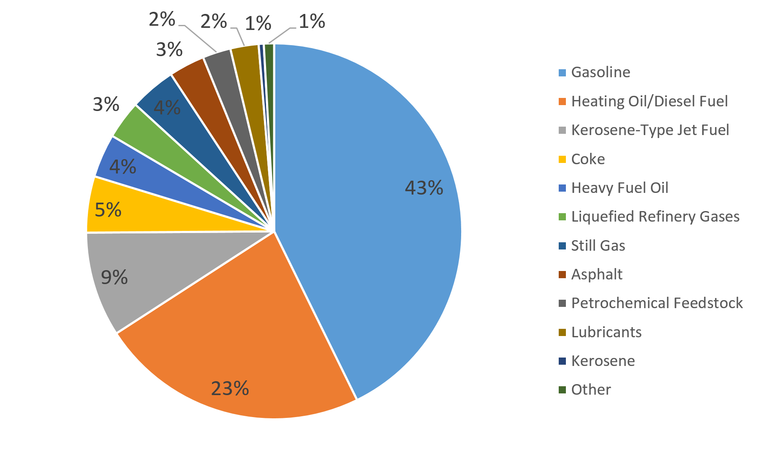In a barrel of oil
A single barrel of crude oil - once it has been refined - can yield a large number of different, useful petroleum products. The ability to obtain products like gasoline, asphalt, and propane from a single product is part of what makes refining such a vital process. The refining process separates these different hydrocarbons in a number of different ways, one major way being separation by boiling point in a fractional distillation tower.
Products of the Refining Process
When crude oil is input into a fractional distillation tower, there is an overall increase in volume of product. If a single barrel of crude oil - equal to about 159 liters - were refined, the volume of the final products is actually greater than the volume of the initial crude oil. In fact, 170 liters of refined petroleum products can be obtained from 159 liters of crude oil. There is an increase in volume through the refining process as a result of an effect known as processing gain. Processing gain simply refers to the volume by which output increases compared to input that occurs as a result of processed petroleum products having a lower specific gravity than the initial crude oil.[1] This results in the final products "taking up more space" than the initial crude oil.

Each product obtained from the refining process is collected in different amounts. In Figure 1, the percentage of the final 170 liter volume that each product makes up is shown in a pie chart. From the image, it is apparent that vehicle fuels make up a large portion of the final product. In liters, gasoline makes up about 73 liters of the final 170, diesel and heating oil make up about 40 liters, while kerosene-type jet fuels make up about 15.5 liters. Despite the fact that these numbers are comparatively large, it does not mean that the other products are not useful. For example, petrochemical feedstocks make up only 4.2 liters of the final 170, however they are used to make a variety of different products from pharmaceuticals to plastics.[4] More information about the vast number of products that can be created with petrochemical feedstocks can be found here.
Other products, including still gas, petroleum coke, heavy fuel oil, asphalt, lubricants, aviation gasoline, naphthas, and waxes make up a fairly small amount of the final product but are widely useful in a number of different applications.
References
- ↑ EIA. (January 9, 2016). Glossary of Terms [Online]. Available: https://www.eia.gov/dnav/pet/TblDefs/pet_pnp_refp2_tbldef2.asp
- ↑ API. (January 9, 2016). Oil Facts [Online]. Available: http://lubinlib.typepad.com/index/files/petrochems.pdf
- ↑ Figure created internally by a member of the Energy Education team
- ↑ GasBuddy (Data from EIA). (January 7, 2016). What does one barrel of crude oil make? [Online]. Available: https://blog.gasbuddy.com/Crude_Products.aspx

